
Medieval Times Dinner & Tournament
Note:
This review is part of our Destination Series1. Although we focus on Salt Lake-area restaurants, we occasionally review restaurants that we think may interest our Salt Lake readers. In this case, we visited Medieval Times in Buena Park (Orange County), California.
He said:
I first heard of Medieval Times over 35 years ago. Although I wanted to visit then and many times since, I never did. Until today. With so much anticipation, I wondered if it could possibly live up to the hype. Kathy kept suggesting it would probably be a bunch of touristy kitsch. Would she be right?
Let’s start at the beginning. What is Medieval Times Dinner & Tournament? Quite simply, it’s a dinner show. The theme of both the dinner and the show is an 11th-century tournament of knights. The show is supposed to include a live jousting tournament. I always wondered if it really would, since that sounds pretty brutal and dangerous to me. Another part of the experience that always appealed to me is that the dinner doesn’t include silverware. After all, they didn’t use silverware in the medieval castles, as far as I know.
Medieval Times really committed to their theme. The building was shaped like a castle. Well, maybe if you squinted. Or if you'd never seen a real castle. All the employees, starting from the parking lot attendant, wore period costumes that were really quite nice. Cast members, like the queen, who mingled with guests before the arena opened, had rather elaborate costumes.
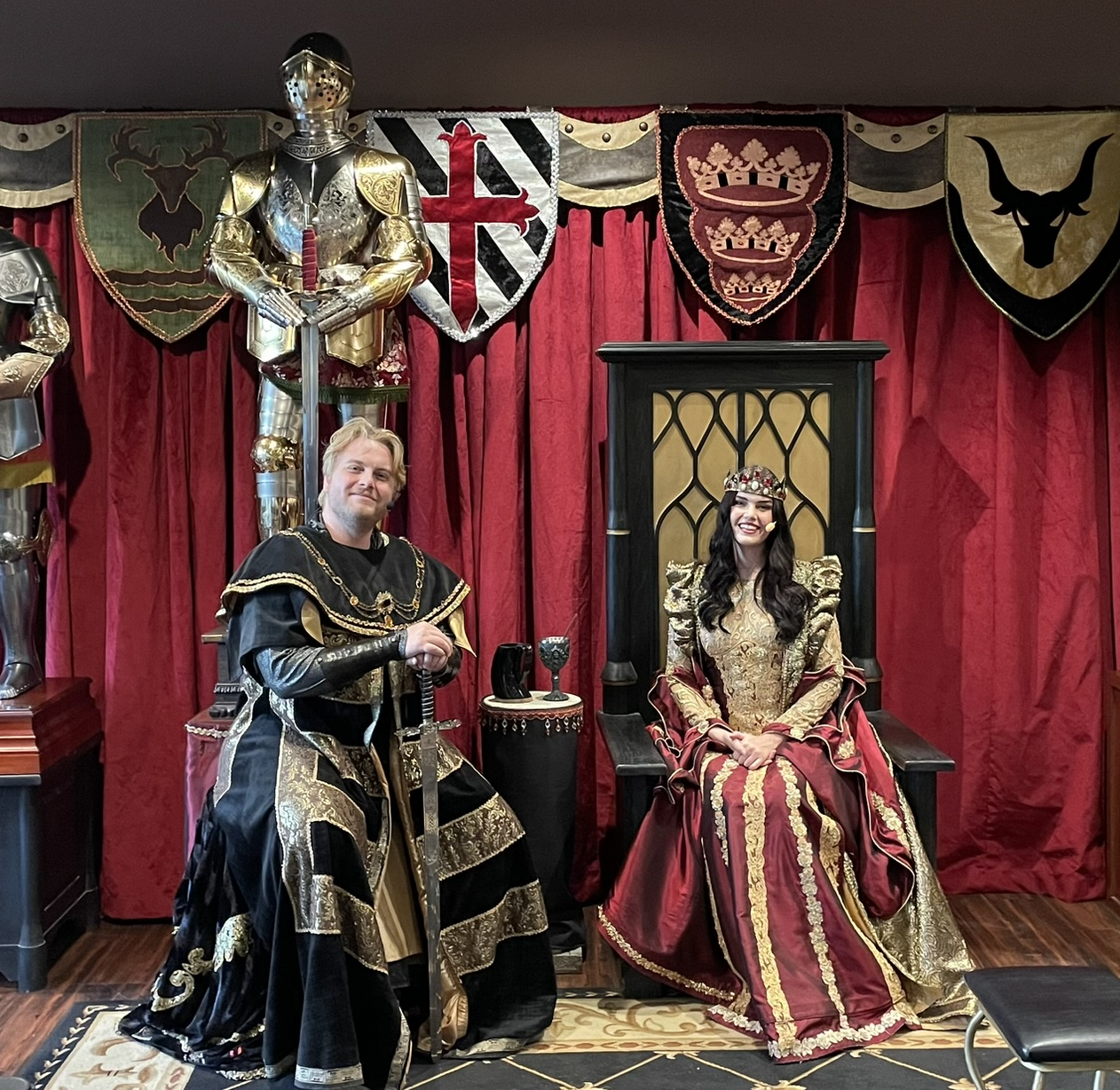
We arrived an hour early, partly because they suggested it, but also because they apparently assigned tables on arrival. We had booked a particular section (and we'd bought a VIP pass that guaranteed better seating), but the tables within each section were assigned on arrival. We ended up with one of the best seats in the arena, right on the front row.
Even though the arena didn’t open that early, there were things to see and do. They took our photo, which was included as part of our VIP package. Then we got to browse the medieval themed décor. Full suits of plate armor formed a perimeter around the space. Each included a short description of its design, as well as a several-thousand-dollar price tag.
Windows provided views into stalls in which some of the program’s horses were stabled. They were all beautiful animals. Many of them sported braided manes or tails. About half were white or mostly white: purebred Andalusian horses. Other horses in the show included American Quarter Horses, and Friesian horses. We also got to peer through a window into the mews, where a beautiful peregrine falcon perched.
While we browsed these and other thematic items, we were also exposed to a variety of sales stations. A couple of stations offered libations in souvenir glasses, steins, horns, or mugs. Other stations offered swords, some realistic and others made of plastic with flashing lights. Pendants, banners, statues, and other wares were also offered. This reminded me of attractions that position their exits in the gift shop. Yet, I was impressed that there was never any pressure. Nobody so much as called to us or waved us over, even when I approached to look at something through the glass. They allowed their merchandise to speak for itself.
All the guests were assigned to one of the show’s knights, based on where their seats were in the arena. We were assigned to the black-and-white knight’s section and given appropriately colored paper crowns to wear. I found a kid in a red crown and told him I was sorry he chose the wrong knight. I told him the black-and-white knight was sure to carry the day. I liked how the assignments to different knights encouraged the audience to cheer for “their” knights2.
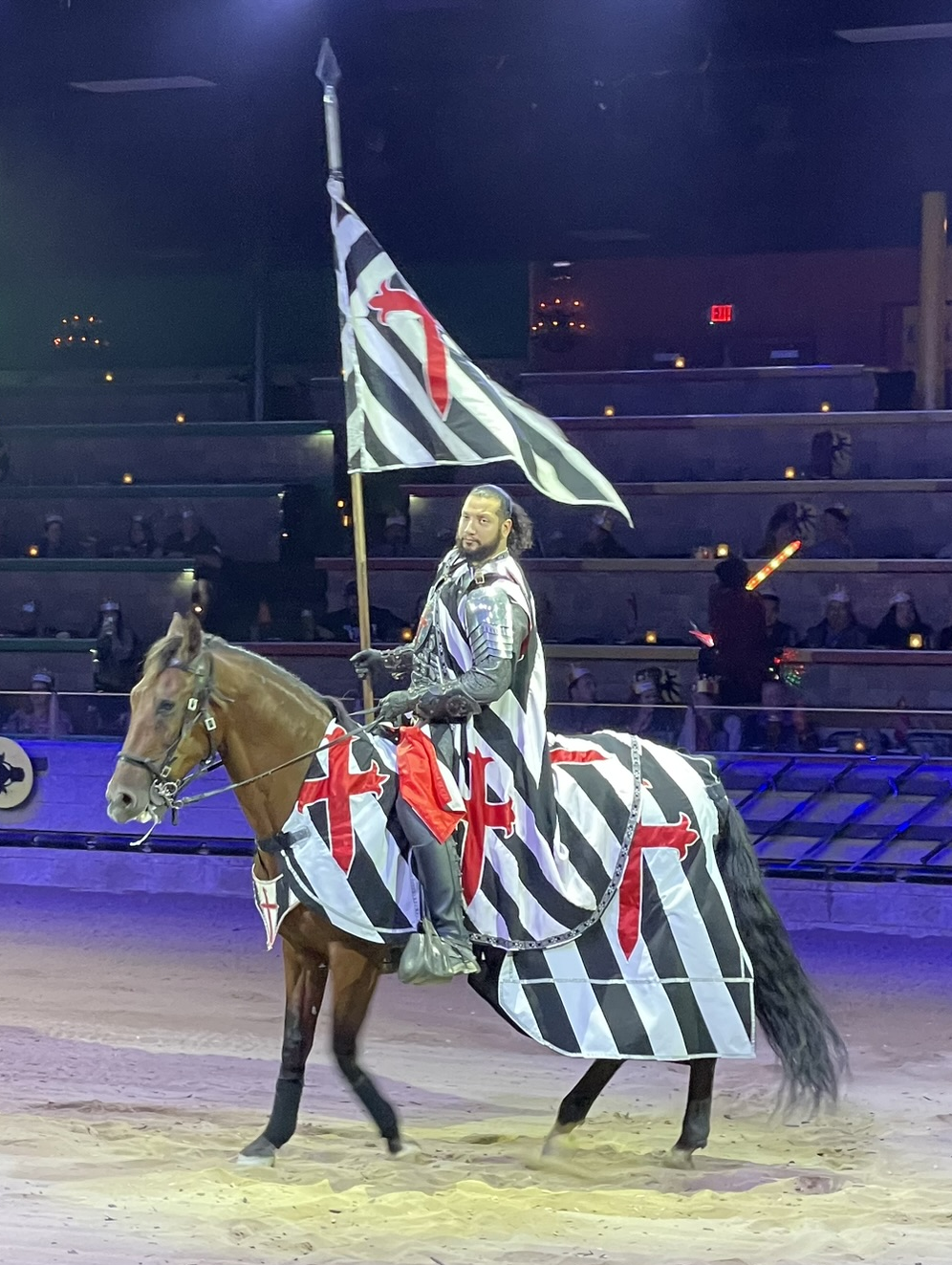
Finally, a recorded rank of heraldic trumpets announced that it was time to enter the arena. The tournament surface was about the size of a hockey rink, though it had a dirt surface. The tables ringed the field in tiers. Each tier had an aisle for the servers, a long table, then theater seats for the guests. I think they had about six rows.
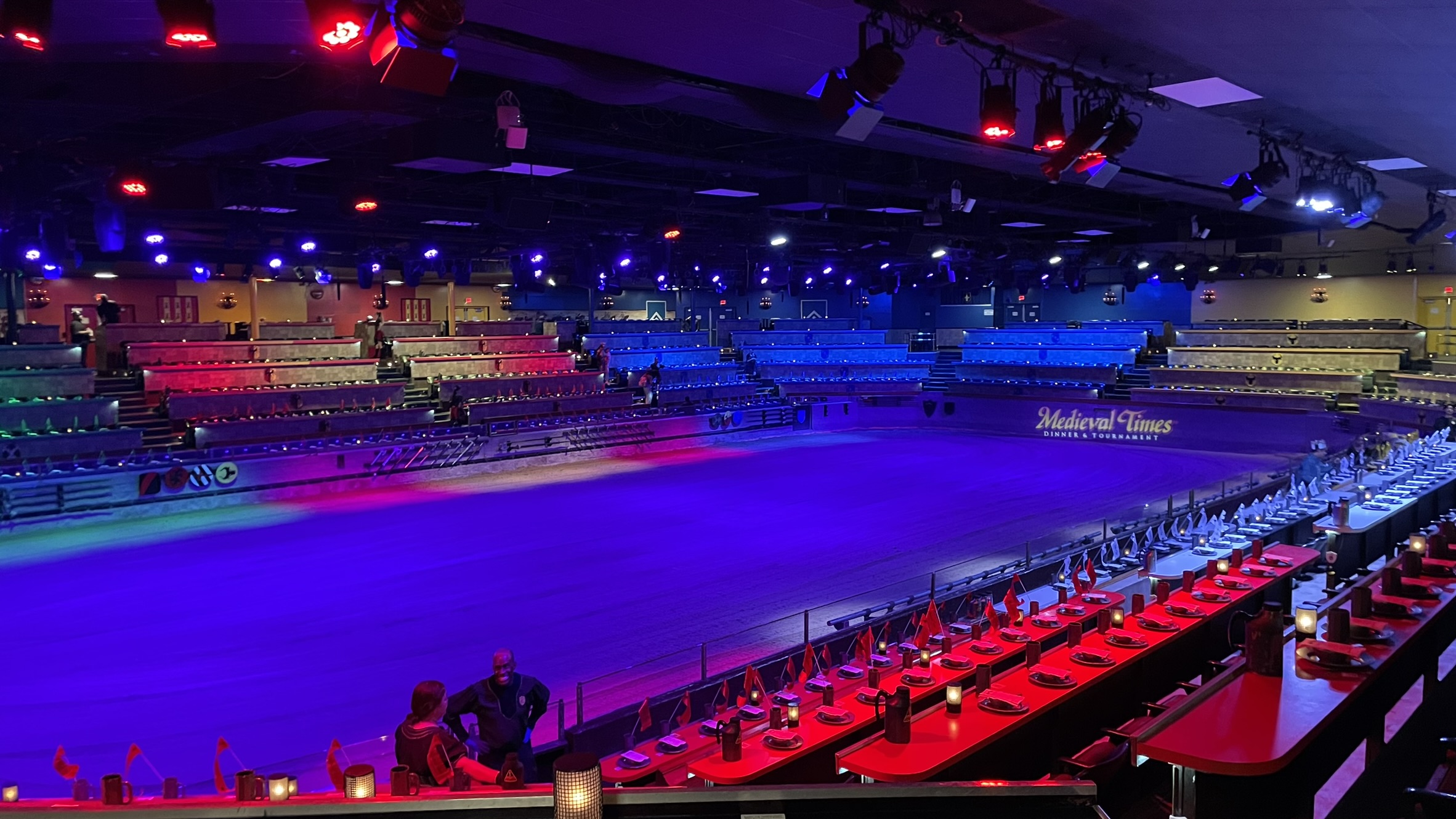
As a youth, I thought that one of the enticing parts of the experience was the primitive aspect of the feast, namely that we wouldn’t get silverware. I don’t know why that always caught my attention. Something about the primal act of grabbing a chicken leg, then devouring it while juice ran down my chin. Well, it turns out that the dinner was only a minor part of the experience. Yes, we got to eat without silverware, but most of our attention was always on the show. With the lights turned down, we could hardly even see our food.
The food was amply serviceable, to be sure. It was even good, though simple, but the show captured my attention, kitsch and all. But first, let me describe the food. Our place settings included a plastic stein, colored like pewter, and a plate and bowl that actually were pewter. The server poured a tomato bisque into our bowls, then gave us each a slice of garlic toast. An entire half chicken followed, which was pleasantly seasoned. It was so tender that the meat easily slid off the bones. We each got a cob of corn that was unexpectedly juicy, and half of a seasoned potato. We finished with an éclair. In a welcome departure from medieval standards, we got to enjoy Diet Pepsi.

But like I said, the real fun was the show. The cast included the queen—Her Majesty Doña Maria Isabella—her advisor, the Master of Horses, six knights, numerous squires, and the Royal Falconer. The horses pranced and knelt and jumped and performed various dressage movements. My favorite was the Capriole. This began with the horse rearing up on two legs, then hopping completely into the air. At the height of the horse’s leap, it then kicked out with its hind legs before landing on all fours.
The horses were certainly impressive and featured repeatedly throughout the show. However, at one point, the Royal Falconer presented her bird. She demonstrated a technique known as “lure flying,” a practice used to increase the falcon’s strength and stamina. The falconer would swing a lure around her in an arc. The falcon would fly around the arena, gathering speed before attacking the lure, which the falconer would pull away. They repeated this several times before the falcon finally “caught” her prey. I loved this part of the show because as the falcon circled the arena, it flew at great speed just inches over our heads. To be honest, it’s a little unnerving to see a killer bird coming right toward you at eighty miles an hour!
Before we reached the joust part of the program, the knights engaged in other contests of skill. One such contest involved racing their horses across the arena while stabbing metal rings with their lances. While Jim Craig may make this look easy in Return to Snowy River (although he used a whip instead of a lance3), it looked incredibly difficult when I saw them set up the tiny rings. Not all the attempts succeeded, but most did.
Eventually, we reached the joust part of the program. My worry over the danger involved only increased when a large net descended from the roof to separate the contest area from the spectators. And sure enough, it was brutal. I thought they might use theatrics to simulate the clashes. There was some of that, like the losing knight throwing himself from his horse, but the speed and contact were quite real. One knight would aim his lance into the other knight’s shield. They used enough force to shatter the lances into pieces. The squires would run out to collect the shards, like ball boys fetching balls in a tennis match.
Once unhorsed, the knights would then engage in hand-to-hand combat. Some used swords. Others used axes or flails. The choreography was good. Sometimes we could see one knight taking a dive or over-exaggerating a hit. But they often attacked with full-strength blows. Sparks flew often as sword met sword. It was tense and exciting.
So, was Kathy right? Was it pretty cheesy? Maybe at times, but what’s wrong with that? I wasn’t looking for a historical reenactment. I wanted to be entertained. And I was. I had a great time, thirty-five years in the making.
She said:
For anyone vacationing in Orange County, California, who wants to be transported to a different era and forget about bumper-to-bumper traffic and honking horns, I’d recommend a jaunt on over to Medieval Times.
Is it touristy? Yes.
Is it cheesy? Oh, yes.
But is it a fun time? Absolutely.
Picture this: Actors dressed up in elaborate costumes. There were squires, wenches, lords, knights, a nobleman, and even a very regal-looking queen. The aristocracy were easy to distinguish from the peasants because their clothing was more flamboyant, colorful, and detailed. Jewel tones, like ruby, emerald, topaz, citrine, etc., as opposed to various shades of brown.
Touring the premises, we walked through the Knight’s Court, where there was seating and where patrons could purchase alcoholic drinks in their choice of goblet, horn, or stein. I wanted to buy glasses to take home as souvenirs, but there were no pint glasses, so that was a no-go. Brian prefers the size and heft of pint glasses in his hand.
Anyway, there was absolutely no shortage of “loot” to purchase and take home. Medieval Times offered everything from colorful stuffed animals, unicorns, plastic swords, metal swords, masks, lady-in-waiting hats, flails, mallets, tiaras, shields, and other manner of kitschy items. 😄
Brian did get me a souvenir that I really liked a lot, though: a figurine of a beautiful fairy wearing an emerald dress and holding a violet-colored dragon hatchling. It’s a lovely keepsake. 💖 And, of course, we got to take home the memory photos they took of us.
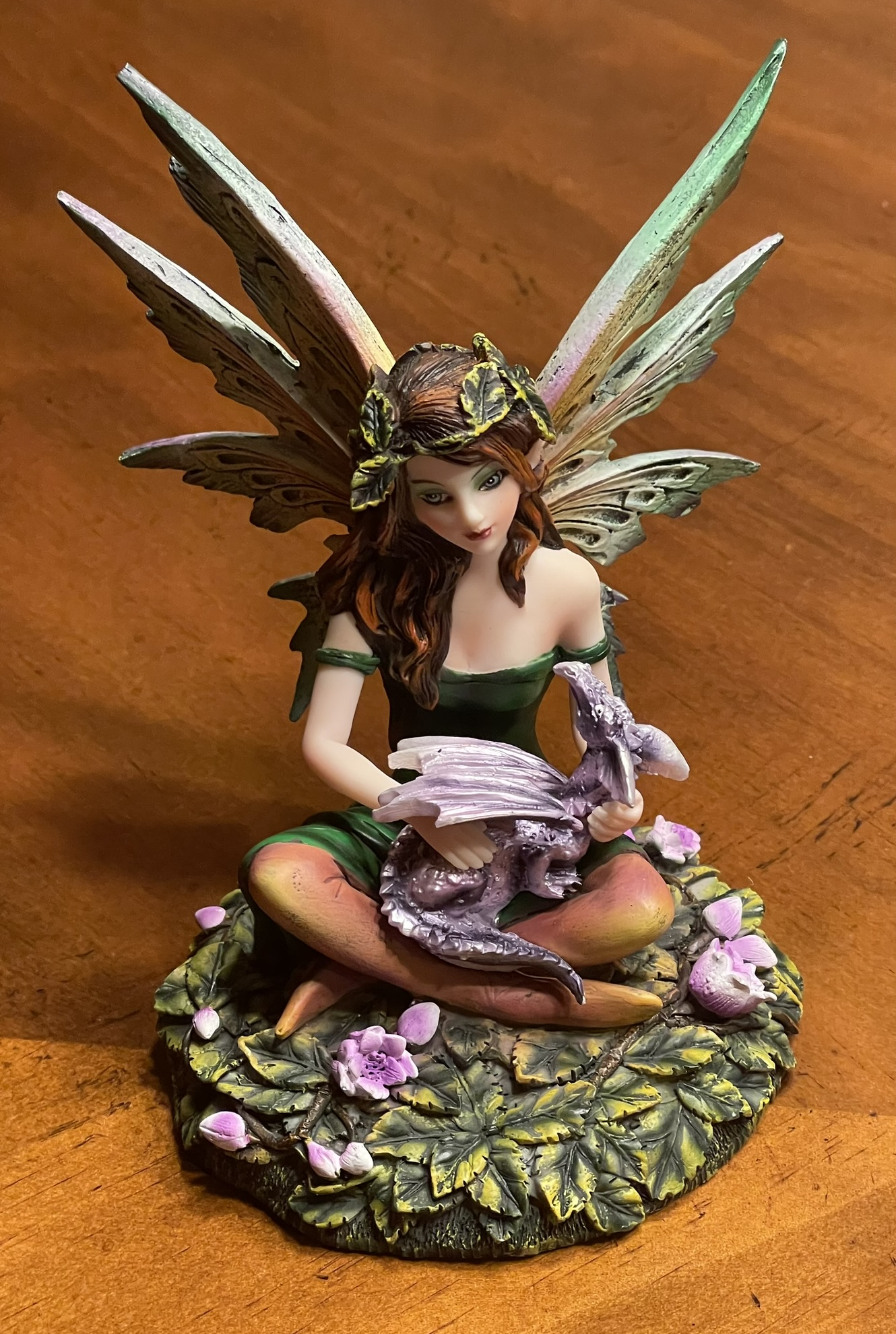
Here are some things I really enjoyed about my experience at Medieval Times:
- Seeing the beautiful, spectacularly trained horses. They were splendid creatures that trotted, pranced, and danced around the arena. Although the white Andalusians were magnificent, my eyes and heart were drawn to the gray one with the braided mane and tail because I’d had an encounter with him prior to the show. He was shaking and he whinnied at me, but it didn’t look like fear. He appeared to be anticipating performing and being free from the confines of his stall.
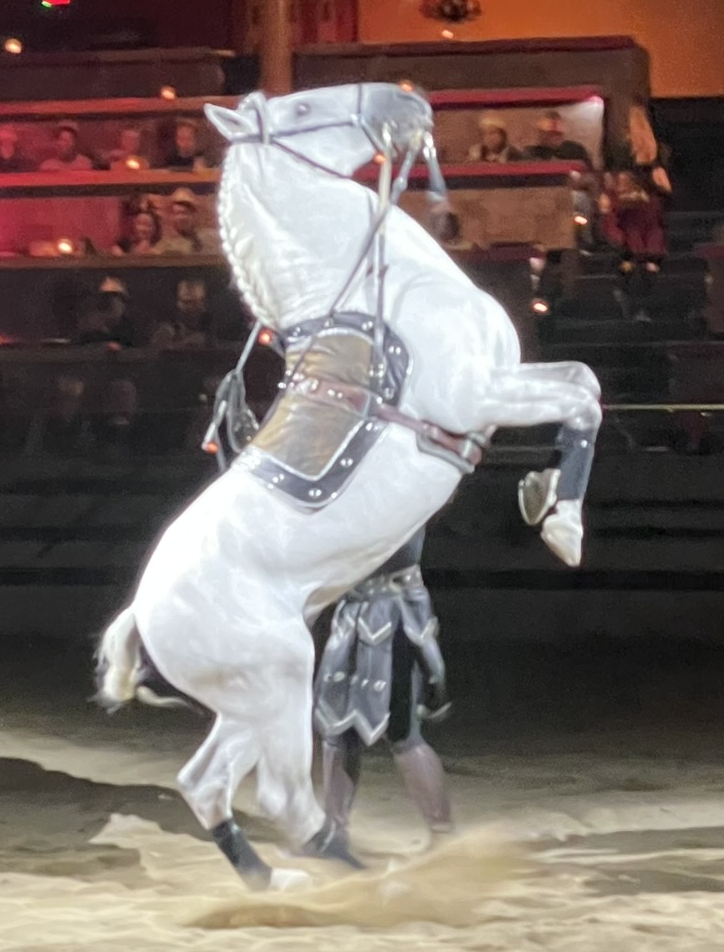
- The show was entertaining with all of the sparring, clashing, clanking, rivalry, and competition being acted out in front of us, but my eyes were riveted on the horses and on the falcon when it was its turn to perform. It flew overhead quickly, swiftly, and with precision. At one point, it flew so close to my head, I could feel the whoosh of air that it produced beneath its wings. It was pretty impressive.
Although the food was fine, especially the tender roasted chicken, I think the point was to view the show and, at times, to interact with the actors with cheers or jeers, immersing ourselves in make-believe for a while.
Conclusion:
Enjoy a bit of escapism by visiting the 11th century. Cheer on your patron knight as he competes for the queen’s favor in a contest of equestrian and knightly games. Kathy suggests you bring a sweater, as the arena was a bit chilly.